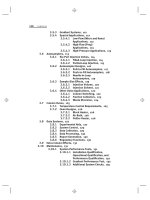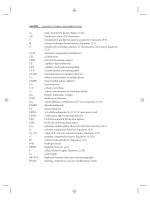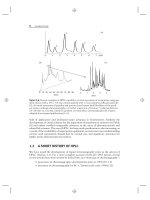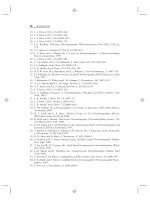- Trang chủ >>
- Sư phạm >>
- Sư phạm toán
Serge lang (auth ) introduction to diophantine approximations new expanded edition springer verlag new york (1995)
Bạn đang xem bản rút gọn của tài liệu. Xem và tải ngay bản đầy đủ của tài liệu tại đây (3.5 MB, 137 trang )
Introduction to Diophantine
Approximations
Springer Books on Elementary Mathematics by Serge Lang
MATH! Encounters with High School Students
1985, ISBN 96129-1
The Beauty of Doing Mathematics
1985, ISBN 96149-6
Geometry (with G. Murrow)
1983, ISBN 90727-0
Basic Mathematics
1988, ISBN 96787-7
A First Course in Calculus
1986, ISBN 96201-8
Calculus of Several Variables
1987, ISBN 96405-3
Introduction to Linear Algebra
1986, ISBN 96205-0
Linear Algebra
1987, ISBN 96412-6
Undergraduate Algebra
1987, ISBN 96404-5
Undergraduate Analysis
1983, ISBN 90800-5
Serge Lang
Introduction to
Diophantine
Approximations
New Expanded Edition
Springer-Verlag
New York Berlin Heidelberg London Paris
Tokyo Hong Kong Barcelona Budapest
Serge Lang
Department of Mathematics
Yale University
New Haven, CT 06520
USA
Mathematics Subject Classifications (1991): l1J25, 11168, 11K60
Library of Congress Cataloging-in-Publication Data
Lang, Serge, 1927-
Introduction to diophantine approximations / Serge Lang.
p. cm.
Originally published: Reading, Mass. : Addison-Wesley Pub. Co.,
1966. Addison-Wesley series in mathematics.
Includes bibliographical references (p. ) and index.
ISBN-13: 978-1-4612-8700-1
I. Diophantine approximation. I. Titlc.
QA242.L24 1995
512'.73-dc20 95-2332
CIP
The original edition of this book was published in 1966 by Addison-Wesley.
Printed on acid-free paper.
© 1995 Springer-Verlag New York, Inc.
Softcover reprint of the hardcover 2nd edition 1995
All rights reserved. This work may not be translated or copied in whole or in part without the
written permission of the publisher (Springer-Verlag New York, Inc., 175 Fifth Avenue, New York,
NY 10010, USA), except for brief excerpts in connection with reviews or scholarly analysis. Use in
connection with any form of information storage and retrieval, electronic adaptation, computer soft-
ware, or by similar or dissimilar methodology now known or hereafter developed is forbidden.
The use of general descriptive names, trade names, trademarks, etc., in this publication, even if the
former are not especially identified, is not to be taken as a sign that such names, as understood by the
Trade Marks and Merchandise Marks Act, may accordingly be used freely by anyone.
Production coordinated by Brian Howe and managed by Terry Kornak; manufacturing supervised by
Jeffrey Taub.
Typeset by Asco Trade Typesetting Ltd., Hong Kong.
987654321
ISBN-13: 978-1-4612-8700-1 e-ISBN-13: 978-1-4612-4220-8
DOl: IO.l 007/978- 1-4612-4220-8
Foreword
I thank Springer-Verlag for keeping my Introduction to Diophantine
Approximations in print. This second edition is unchanged from the first,
except for the addition of two papers, written in collaboration with
W. Adams and H. Trotter, giving computational information for the
behavior of certain algebraic and classical transcendental numbers with
respect to approximation by rational numbers and their continued frac-
tions. I thank both of them for their agreement to let me reproduce
these papers, which expand and illustrate the general theory in computa-
tional directions.
The classical numbers, as I described them in 1965, are those which
can be obtained by starting with the rational numbers, and performing
the following operations:
- Take the algebraic closure, thus obtaining a field F.
- Take a classical, suitably normalized transcendental function (elliptic,
hypergeometric, Bessel, exponential, logarithm, etc.), or jazzed up ver-
sions, coming from normalized transcendental parametrizations of alge-
braic varieties, take values of such functions with argument in F, and
adjoint them to F.
- Iterate these two operations inductively.
Questions arise as to the properties of the numbers so obtained (a
denumerable set), from the point of view of diophantine approximations.
The present book may be viewed as providing the simplest examples at
the most elementary level. using only the most elementary language of
mathematics.
New Haven, 1995 SERGE LANG
Foreword to the First Edition
The quantitative aspects of the theory of diophantine approximations are,
at the moment, still not very far from where Euler and Lagrange left
them. Very recent work seems to have opened some fruitful lines of
research, and in this book we shall illustrate by significant special exam-
ples three aspects from the theory of diophantine approximations.
First, the formal relationships which exist between various counting
processes and functions entering in the theory. These essentially occur in
Chapters I, II, III.
Second, the determination of these functions for numbers which are
given as classical numbers, in a concrete fashion. Chapters IV and V
give examples of this.
Third, we have mentioned certain asymptotic estimates holding almost
everywhere (e.g. the Khintchine theorems and the Leveque-Erdos-
Schmidt theorems). Such results are useful since they suggest roughly
what may be considered "pathological" numbers, and also the range of
magnitude of similar estimates for the classical numbers. However, as
one sees from the quadratic numbers (which are of constant type), and
the Adams result for e, each special number may exhibit its own particu-
lar behavior in the more subtle range of approximation. To determine
this behavior for the classical numbers is perhaps the most fascinating
part of the theory of diophantine approximations.
There exist other aspects, for instance the connection with transcen-
dental numbers, but these have been left out completely since the style of
the results known in this direction is at present so different from the style
of the results which we have emphasized here.
I have avoided including partial results whose statements seemed to
me too remote from expected best possible statements. Every chapter
viii FOREWORD TO THE FIRST EDITION
should be viewed as working out a special case of a much broader
general theory, as yet unknown. Indications for this are given through-
out the book, together with references to current publications.
It is unusual to find a mathematical theory which is in a state as
primitive and naive as the present one, and there is of course some
delight in catching it in that state. In fact, this book may be used for a
course in number theory, addressed to undergraduates, who will thus be
put in contact with interesting but accessible problems on the ground
floor of mathematics. If, however, like Rip van Winkle, I should awake
from slumber in twenty years, my greatest hope would be that the theory
by then had acquired the broad coherence which it deserves.
Berkeley, 1966 SERGE LANG
Contents
Foreword.......................................................... v
Foreword to the First Edition . . . . . . . . . . . . . . . . . . . . . . . . . . . . . . . . . . . . . . . . vii
CHAPTER I
General Formalism . . . . . . . . . . . . . . . . 1
§1. Rational Continued Functions . . . . . . . . 1
§2. The Continued Fraction of a Real Number 6
§3. Equivalent Numbers ... 11
§4. Intermediate Convergents . . . . . . . . . . . 15
CHAPTER II
Asymptotic Approximations 20
§1. Distribution of the Convergents 20
§2. Numbers of Constant Type 23
§3. Asymptotic Approximations 25
§4. Relation with Continued Fractions 32
CHAPTER III
Estimates 01 Averaging Sums 35
§1. The Sum of the Remainders 35
§2. The Sum of the Reciprocals 37
§3. Quadratic Exponential Sums 41
§4. Sums with More General Functions 45
CHAPTER IV
Quadratic Irrationalities 50
§1. Quadratic Numbers and Periodicity 50
§2. Units and Continued Fractions 55
§3. The Basic Asymptotic Estimate 61
x CONTENTS
CHAPTER V
The Exponential Function 69
§l. Some Continued Functions .. 69
§2. The Continued Fraction for e 72
§3. The Basic Asymptotic Estimate 73
Bibliography 79
APPENDIX A
Some Computations In Diophantine Approximations . . . . . . . . . 81
By W. ADAMS and S. LANG
Reprinted from J. reine angew. Math. 220 (1965), pp. 163-173.
APPENDIX B
Continued Fractions for Some Algebraic Numbers . . . . . . . . . . 93
By S. LANG and H. TROTTER
Reprinted from J. reine angew. Math. 255 (1972), pp. 112-134.
APPENDIX C
Addendum to Continued Fractions for Some Algebraic Numbers 126
By S. LANG and H. TROTTER
Reprinted from J. reine angew. Math. 267 (1973), pp. 219-220.
Index 129
CHAPTER
General Formalism
I, §1. RATIONAL CONTINUED FRACTIONS
We are interested in the following problem. Given an irrational number
oc, determine all solutions of the inequality
1
(1) Iqoc - pi <- or
q
with integers q, p, or more generally, of an inequality
(2) Iqoc - pi < I/!(q),
where I/! is some positive decreasing function of a real variable. If ~ is a
real number, we may write II~II for the distance between ~ and the
nearest integer. Then Iqoc - pi = Ilqocll whenever it is sufficiently small,
and we may rewrite the fundamental inequality (1) in the form Ilqocll < 1/q.
In investigating Ilqocll, we are therefore interested only in the residue class
of qoc modulo Z, where Z is the additive group of integers. The factor
group R/Z (R = real numbers) is sometimes called the circle group, since
it is isomorphic to the group of complex numbers of absolute value 1
under the mapping x 1--+ e21tix• We may think of II II as a metric on the
circle R/Z.
The inequality (1) plays a fundamental role, and it turns out that one
can describe most of its solutions by a rational process. In this chapter,
we shall describe this process. The more general inequality (2) will be
considered in the next chapter.
2 GENERAL FORMALISM [I, §lJ
Unless otherwise specified, the results of this chapter are due to Euler
and Lagrange. (For specific references, cf. Perron [21J, which contains an
extensive bibliography of the older literature, and is an excellent reference.)
We start by considering independent variables ao, ai' a2, . ... We shall
define inductively pairs of polynomials
and
starting with Po = ao and qo = 1. The quotient Pn/qn will be written
Suppose that we have defined Pk' qk with k < n, and n ~ 1. We shall
use the abbreviation
and
We define inductively
(3) and
This implies that
(4) [ J Pn 1
ao, ... ,an = - = ao + [ J'
qn ai ,··· ,an
which, written in full, is equal to
1
ao + ----1:---
ai + -----:1-
a2+--
a3 +
The sequence of fractions {Pn/qn} is called a continued fraction. When we
substitute numbers for ao, ai' ... such that qn does not vanish, we obtain
a sequence of numbers, which is still called a continued fraction.
Theorem 1. We have for n ~ 2,
Pn = anPn-i + Pn-2'
[I, §1] RATIONAL CONTINUED FRACTIONS 3
Proof. For n = 2, the assertion is verified directly. Assume n> 2, and
assume inductively that
P~-l = a.p~-2 + P~-3'
Using (3), we find
P. = ao(a.p~-2 + P~-3) + a.q~-2 + q~-3
= a.(aOP~-2 + q~-2) + aOP~-3 + q~-3
= a.p.-1 + P.-2
and
q. = a.p~-2 + P~-3 = a.q.-1 + qn-2'
thereby proving our theorem.
For convenience, we define P-1 = 1 and q-1 = O. Then Theorem 1
remains valid when n = 1.
In applications, we shall be interested in the nature of the values of Pn
and q. when we substitute real numbers, for ao, a1 , •••• We shall always
take a1 , a2 , ... to be > O. In that case, we see inductively that q. > 0 for
n ~ 1, and hence that the fraction Pn/qn has meaning as a real number.
In particular, we obtain a corollary for Theorem 1.
Corollary 1. Let ai be real numbers > 0 for 1 ;::;; i ;::;; n. For 1 ;::;; k ;::;; n,
let
Then
Pk-1 rk + Pk-2
qk-1 rk + qk-2
Corollary 2. Let ao , ... ,an and bo , ... ,bn be real numbers such that
ai ~ 1 for i ~ 1 and also bi ~ 1 for i ~ 1. Assume that aj' bj are inte-
gers for 0 ;::;; j ;::;; n - 1. If
then ai = bi for i ~ o. [ao, ... ,an] = [bo , ... ,bn],
Proof. Let r1 = [al' ... ,an], so that
4 GENERAL FORMALISM [I, §1]
Then r1 ~ 1, and similarly, Sl = [b1 , •.. ,b.] ~ 1. By hypothesis,
If r1 = 1, then
is an integer, and hence 1/s1 is also an integer. Hence Sl = 1 and ao = boo
If r1 > 1, then
is not an integer, and hence Sl > 1 also. But then ao = bo because both
ao, bo are the greatest integers ~ [ao,' .. ,a.]. Thus in all cases, ao = bo
and r1 = Sl' We can now conclude the proof by induction.
Corollary 2 gives us a uniqueness for the continued fraction formed
with real numbers under the hypotheses of this corollary. It will be
applicable in the next section.
For the next theorem, we return to indeterminates.
Theorem 2. For n ~ 0 we have
Proof We have
In general, multiply the first expression in Theorem 1 by Q.-1' multiply
the second by P.-l' and subtract the first from the second. We obtain
This proves the theorem, because it shows that when n changes by one
unit, the expression on the left of the inequality in the theorem changes
by a minus sign.
CoroUary 1. For n ~ 1 we have
P.-l P. (-1)·
[I, §I] RATIONAL CONTINUED FRACTIONS 5
We shall be interested in the values taken by Pn and qn when ao, al' ...
are integers. We shall assume throughout that when we substitute such
integers, then al , a2 , ••• are always > O.
Corollary 2. If al , a2, . .. are positive integers, then Pn and qn are
relatively prime, and
forms a strictly increasing sequence of integers.
Corollary 3. Let a denote the rational function
Then
( -It+l
qn+1 a - Pn+1 = - - - - -
an+2qn+1 + qn
Proof. Replace n by n + 2 in the theorem, and divide by qn+2' Note
that by definition, Pn+2/qn+2 = a, and qn+2 = an+2qn+1 + qn' The relation
of our corollary then drops out.
Theorem 3. For n ~ I we have
Proof. We multiply the first expression in Theorem I by qn-2' multi-
ply the second by Pn-2 and subtract the first from the second. We
obtain, using Theorem 2,
as was to be shown.
Corollary 1. For n ~ 2 we have
Pn-2 Pn (-It-lan
----=----
qn-2 qn qnqn-2
Corollary 2. If a l , a2, ... are positive numbers, then the sequence Pn/qn
for even n is strictly increasing, and for odd n, it is strictly decreasing.
Corollary 3. Let a denote the rational function
Then
6 GENERAL FORMALISM [I, §2]
Proof Replace n by n + 2 in Theorem 3, and divide by qn+Z' Note
that by definition, Pn+zlqn+z = 0(, and qn+2 = an+2 qn+1 + qn' The relation
of our corollary then drops out.
Theorem 4. For n ~ 1 we have
Proof For n = 1, the assertion IS clear. Assume n> 1. Suppose
inductively that we know
-qn--1 = [ an-I' ... ,a1] .
qn-2
and our assertion follows by induction.
I, §2. THE CONTINUED FRACTION OF A REAL NUMBER
Consider first briefly the special case of a rational number 0(. Let ao be
the largest integer ~ 0(. If 0( is not an integer, we can write
with 0(1 > 1, and 0(1 is again rational. Inductively, we let
1
O(n = an + - - ,
O(n+1
where an is the largest integer ~ O(n and O(n+1 > 1. We can do this pro-
vided O(n is not an integer. However, our process will stop after a finite
number of steps. Indeed, if O(n = alb is a rational number, not an integer,
with positive integers a, b, then
a - ban C
0( -a =----=-
n n b b
[I, §2] THE CONTINUED FRACTION OF A REAL NUMBER 7
with c < b. Then
b
IXn+1 = -
C
and hence the denominator of IXn+! is smaller than the denominator of IX.
SO the process stops, and we can write our rational number IX in the
form
with integers ai (i = 0, ... ,n), and ai ~ 1 for i ~ 1. Observe that we have
a choice for the last partial quotient an, namely we can write IX in the
above form with an equal to an integer > 1, or also in the form
IX = [a o, a 1 , ••• ,an - 1, 1].
Thus the length of the continued fraction expansion of a rational number
may be taken to be either even or odd.
Let IX be a real irrational number. We can determine a continued
fraction for IX by writing as before IX = ao + I/IX1 with ao equal to the
largest integer ~ IX (that is, ao = [IX]), and IX1 > 1. Inductively, we let
1
IXn = an + --,
IX.+1
where an is the largest integer ~ IXn' and IXn+! > 1. Since IX is irrational,
the sequence IX1' IX2' .•• does not terminate. We have, in the notation
of §1,
for any n ~ 0. We shall also write symbolically the infinite expression
From Corollary 2 of Theorem 2, we obtain a sequence of relatively prime
integers Pn' qn with qn ~ 1, belonging to the continued fraction [ao, ... ,an],
and thus the relation
is now a relation between real numbers, not any more between indeter-
minates. Furthermore, Pn/qn is a reduced fraction, which will be called
the n-th principal convergent of IX. We call an the n-th partial quotient
of IX.
8 GENERAL FORMALISM [I, §2]
The formalism of §1 now applies to the continued fraction for!J.. For
instance, the Corollaries 3 of Theorems 2 and 3 must now be written
(_1)n+1
qn+1!J. - Pn+l = - - - - -
!J.n+2qn+1 + qn
and
We always have
and an ~ 1 for all n ~ 1. Hence the denominators qn are all positive
integers, and form an increasing sequence,
0< ql < ... < qn < qn+l < ....
Theorem 5. For even n, the n-th principal convergents of !J. form a
strictly increasing sequence converging to!J.. For odd n, the n-th princi-
pal convergents of !J. form a strictly decreasing sequence converging to !J..
Furthermore, we have
1 1 1
~- < < Iqn!J. - Pnl < --.
2qn+l qn+l + q. q.+l
Proof. The first assertion follows from Corollary 2 of Theorem 3, §1,
and Corollary 1 of Theorem 2. So does the inequality on the right. The
left inequality follows from Corollary 1 of Theorem 3, §1, namely
!J. - Pnl > Ipn+2 _ p'l = an+2 = an+2
I qn qn+2 qn qn+2qn (a.+ 2q.+1 + qn)q.·
We divide numerator and denominator by an+ 2 and use the fact that
an+ 2 ~ 1 to conclude the proof.
The picture illustrating Theorem 5 may be drawn as follows:
P2m-2 P2m+1 P2m-l
q2m-2 q2m+1 q2m-l
[I, §2] THE CONTINUED FRACTION OF A REAL NUMBER 9
Since qn+1 > qn' we find that our convergents give us solutions of the
inequality (1), namely
We shall determine in §3 what other possible solutions may exist.
We observe that for n ~ 1 we have
Corollary. For n ~ 2 we have
whence Ilqn-11X11 = anllqnlXll + Ilqn+1 lXli,
and IlqnlXlI < Ilqn-11X1i,
Proof We use Theorem 1 to express qn+11X - Pn+l> and then use the
fact that qn+11X - Pn+1 and qnlX - Pn have opposite signs by Theorem 5.
This proves the first relation of the corollary. The others are immediate
consequences.
We shall now characterize the principal convergents to IX by an order-
ing property.
A best approximation to IX is a fraction plq (q > 0) such that
IlqlXll = IqlX - pI, and IIq'lXll > IlqlXll
if 1 ~ q' < q. Observe that the fraction plq is necessarily reduced (i.e. p, q
must be relatively prime) if it is a best approximation to IX, for otherwise,
we can write p = p'r, q = q'r with r > 1, and q' < q, so that
Iq'lX - p'l < IqlX - pI,
which is impossible.
Theorem 6. The best approximations to IX are the principal convergents
to IX. In fact, for n ~ 1, qn is the smallest integer q > qn-l such that
IIqlXll < IIqn-11X1I·
Proof Let us first show that a best approximation is a convergent.
Let alb be a reduced fraction, b > 0, which is a best approximation to IX.
We must show that alb = Pnlqn for some n. Suppose that alb < Polqo = ao.
Then
10 GENERAL FORMALISM [I, §2]
contradicting the hypothesis. Suppose that alb > pdql' Then
whence
again contradicting the hypothesis. Finally, suppose that alb lies between
Pn-l/qn-l and Pn+l/qn+1' but is not equal to either of these fractions.
Then
Hence qn < b. On the other hand,
whence
1
Iqn a - Pnl < - ~ Iba - ai,
qn+l
contradiction. This proves the first half of the theorem.
We shall prove the converse, by induction on n. First for n = 0, since
qo = 1, there is no q such that 1 ~ q < qo. Hence the definition of best
approximation is vacuously satisfied by Po/qo' Assume now that our
assertion has been proved for Pn/q. with n ~ O. We wish to prove that
Pn+l/qn+l is a best approximation. Let q be the smallest integer > q.
such that
and let P be such that Ilqall = Iqa - pI. Then by the inductive prop-
erty that Pn/qn is a best approximation, we conclude that p/q is a best
approximation also, and hence must be a principal convergent by what
has already been shown. Since q is chosen smallest > qn such that
Ilqall < Ilqnall, it follows that q = qn+1' But then P = Pn+1 (trivially), there-
by proving our theorem.
Corollary 1. If p/q is a principal convergent to a, and m is an integer
with 1 ~ m < q, then
1
2q < Ilmall·
[I, §3] EQUIVALENT NUMBERS 11
Proof Suppose that q = qn. By Theorem 5, we have
and by Theorem 6, Ilqn-lall ~ Ilmall, as was to be shown.
Corollary 2. If alb is a reduced fraction, b > 0, such that
then alb is a principal convergent to a.
Proof By the theorem, it will suffice to prove that alb is a best
approximation to a. Let cld be a fraction, d > 0, cld i= alb, such that
1
Ida - cl ~ Iba - al < 2b·
Then
From this we conclude b < d, whence alb is a best approximation to a,
as was to be shown.
I, §3. EQUIVALENT NUMBERS
The set of matrices
with integral components a, b, c, d having determinant ± 1 (i.e. ad - bc = 1
or -1) is in fact a group, for the product of two such matrices and the
inverse of such a matrix again have determinant ± 1. Let G be this
group. If a is an irrational number, and u is as above an element of G,
we define
aa + b
ua=--.
ca + d
Then one verifies by brute force that if u, 1: E G then
and Ia = a









